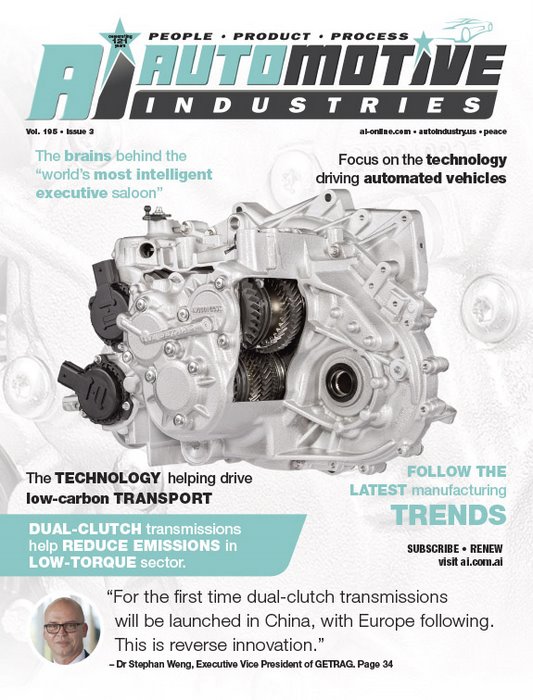
With stricter legislation for lower emissions more efficient powertrain systems are rapidly dictating to the market the requirement for new technologies such as hybridization and electrification. This trend led to Magna International acquiring the GETRAG Group in January 2016.
GETRAG is one of the world’s leading independent suppliers of automotive transmissions. “Expanding our business to provide complete powertrain solutions has been a strategic priority for us,” said Jake Hirsch, Magna Powertrain President. “We believe that GETRAG is an excellent fit in terms of product, technology, footprint, customers and people and look forward to working together to continue building on their history of innovation.”
GETRAG believes transmissions will play a key role in mating traditional internal combustion engine-propelled systems with the higher levels of electrification that supports the rapidly-growing trend towards hybridization. The company believes that its dual clutch transmissions enable the use of hybrid powertrains and provide the option of sporty or comfort driving modes. The system will also support requirements for low fuel consumption and lower emissions. Manual transmissions will continue to play an important role in the future due to their robustness, cost-efficiency and maximum direct response characteristics. “Our goal is to combine the strengths of both companies and offer OEMs complete powertrain solutions. Hybridization and electrification of vehicles are certainly areas which we will continue to develop, and where our combined skills, capabilities and resources will lead to even better overall results. This will also allow us to expand our existing product portfolio, particularly in the driveline area,” said Hirsch in an earlier interview.
In April 2016 Magna announced that Dongfeng GETRAG Transmission, a 50/50 joint-venture formed in 2012 between GETRAG and Dongfeng Motor Group, had started serial production at its plant in Wuhan, China. The plant is manufacturing the GETRAG 6DCT150, a third-generation dual-clutch transmission (DCT) with a new compact gear design that was developed jointly by the partners. The 6DCT150 is a six-speed DCT developed for front-transverse applications in small and compact cars. With six forward gears, one reverse gear and a wet clutch, the automatic transmission addresses market demands in China for a smaller, lower weight system. In addition, the transmission could contribute to a favourable fleet fuel-consumption rating as well as lower fuel costs for individual vehicle purchasers.
Another DCT family member, the GETRAG 6DCT200 will be introduced to the Chinese market in 2017. Dongfeng GETRAG Transmission Co., Ltd. is one of two GETRAG engineering and manufacturing joint ventures in China. “The joint development of 6DCT150 and 6DCT200 together with Dongfeng shows that we take the Chinese market and its requirements very seriously,” says YoungHo Lee, GETRAG Asia Pacific CEO. “We believe that economic growth, automation and climate change will drive the developments in our industry.”
Automotive Industries (AI) asked Dr Stephan Weng, Executive Vice President of GETRAG, how the acquisition by Magna helped GETRAG expand its operations in China.
Weng: The acquisition helps us to diversify our customer portfolio. By combining the strengths and contacts of both companies we can achieve more together than we could separately. This gives us great growth opportunities in the biggest automotive market.
AI: How important is China to GETRAG, and why?
Weng: GETRAG has been present in China since 2007, and has a broad base there with its two joint ventures, Dongfeng GETRAG Transmission Co. and GETRAG (Jiangxi) Transmission Co. As we grow in the East, our business in the West benefits. With our products and solutions developed for the Asian market we are very active in the fastest-growing market in the world. At the same time these products and solutions are rounding out our technology portfolio worldwide. Moreover, China is becoming more and more important in the dual-clutch transmission segment. Forecasts say that by 2022 the volume will grow there by 3.5 million.
AI: Why are the 6DCT150 and 6DCT200 transmissions important in your overall strategy?
Weng: For the first time dual-clutch transmissions will be launched in China, with Europe following. This is reverse innovation. The transmissions stand out for their compactness and low weight. They also contribute to high fleet fuel economy and decrease fuel costs. Most of all, these efficient transmissions are intended for the small, modern, economical cars that are gaining importance in metropolitan areas worldwide. We are gearing up to industrialize the 6DCT150 and 6DCT200 in Europe, which will allow us to serve the low-torque segment here as well.
AI: How are tougher emission standards impacting automotive manufacturers?
Weng: Emission caps are getting more and more stringent, requiring even greater vehicle efficiency. This is forcing the OEMs and suppliers like us to take sophisticated fuel-saving measures, such as lightweight construction, electrification, hybridization, downsizing, etc. Naturally, this enormously increases development and production costs. We therefore need to work intensively together and use innovative technologies and lean processes to reduce emissions further and also to lower costs.
AI: Where do you see GETRAG’s future growth coming from?
Weng: We will grow in Europe and China in particular. Our dual-clutch technology will especially contribute to this. Its modular architecture and scalable functionality allows efficient and customized transmission solutions on a global scale. Our DCTs use a single module with a high proportion of identical parts that can be used flexibly in various torque classes and can be applied through software. The GETRAG hybrid transmissions are variants of these DCTs, designed with torque-split architecture. The high-RPM electric motor is arranged axially parallel to a sub-transmission. In every configuration — from conventional DCTs to 48V to 400V hybrids — this arrangement allows the electric motor’s “My goal is to align the company so that the technological synergies of the Magna acquisition can quickly yield perceivable customer benefits.” performance to be scaled for mild to plug-in hybrids without regard to the installation space. AI: What are the challenges for you personally in taking over the running of GETRAG? Weng: The big challenge is certainly to meet the customers’ demand for high flexibility, facing an environment of growing insecurity and with a product requiring intensive investment.
AI: What plans do you have for the immediate future of the company?
Weng: My goal is to align the company so that the technological synergies of the Magna acquisition can quickly yield perceivable customer benefits.









More Stories
Towing Services Explained: 6 Key Facts You Need to Know
Environmental Factors That Influence Ceramic Coating Choices
Professional vs. DIY Tinting: What You Should Know